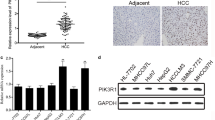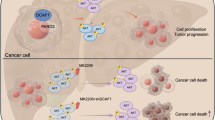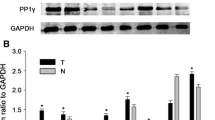Abstract
Curcumin, a yellow component of turmeric or curry powder, has been demonstrated to exhibit anti-carcinogenic effects in vitro, in vivo, and in human clinical trials. One of its molecular targets is protein kinase C (PKC) which has been reported to play essential roles in apoptosis, cell proliferation, and carcinogenesis. In this study, PKC mRNA expression was significantly inhibited in curcumin-treated human hepatocellular carcinoma (HCC) Hep 3B cells identified using a kinase cDNA microarray. Furthermore, curcumin decreased total protein expression of all PKCs in a time-related manner by immunoblotting of whole cell lysates, nuclear, membrane, and cytosolic fractions. In cytosolic fraction, the expression of PKC-α was totally inhibited by curcumin. In contrast, the expression levels of PKC-ζ and -μ were dramatically increased. Increases in expression of PKC-δ and PKC-ζ in the membrane and nucleus, and PKC-ι in the membrane were detected. In summary, the changes in expression and distribution of subcellular PKC isoforms in curcumin-treated Hep 3B cells suggest possible PKC-associated anti-tumor mechanisms of curcumin and provide alternative therapies for human HCC.




Similar content being viewed by others
References
Bengmark S, Mesa MD, Gil A (2009) Plant-derived health: The effects of turmeric and curcuminoids. Nutr Hosp 24:273–281
Goud VK, Polasa K, Krishnaswamy K (1993) Effect of turmeric on xenobiotic metabolising enzymes. Plant Foods Hum Nutr 44:87–92
Arun N, Nalini N (2002) Efficacy of turmeric on blood sugar and polyol pathway in diabetic albino rats. Plant Foods Hum Nutr 57:41–52
Shehzad A, Wahid F, Lee YS (2010) Curcumin in cancer chemoprevention: Molecular targets, pharmacokinetics, bioavailability, and clinical trials. Arch Pharm Chem Life Sci 9:489–499
Anand P, Sundaram C, Jhurani S, Kunnumakkara AB, Aggarwal BB (2008) Curcumin and cancer: An “old-age” disease with an “age-old” solution. Cancer Lett 267:133–164
Goel A, Kunnumakkara AB, Aggarwal BB (2008) Curcumin as “Curecumin”: From kitchen to clinic. Biochem Pharmacol 75:787–809
Llovet JM, Burroughs A, Bruix J (2003) Hepatocellular carcinoma. Lancet 362:1907–1917
Llovet JM, Ricci S, Mazzaferro V, Hilgard P, Gane E, Blanc JF, de Oliveira AC, Santoro A, Raoul JL, Forner A, Schwartz M, Porta C, Zeuzem S, Bolondi L, Greten TF, Galle PR, Seitz JF, Borbath I, Haussinger D, Giannaris T, Shan M, Moscovici M, Voliotis D, Bruix J (2008) Sorafenib in advanced hepatocellular carcinoma. N Engl J Med 359:378–390
Meinhardt G, Roth J, Hass R (2000) Activation of protein kinase C relays distinct signaling pathways in the same cell type: Differentiation and caspase-mediated apoptosis. Cell Death Differ 7:795–803
Hofmann J (2004) Protein kinase C isozymes as potential targets for anticancer therapy. Curr Cancer Drug Targets 4:125–146
Griner EM, Kazanietz MG (2007) Protein kinase C and other diacylglycerol effectors in cancer. Nat Rev Cancer 7:281–294
Assender JW, Gee JM, Lewis I, Ellis IO, Robertson JF, Nicholson RI (2007) Protein kinase C isoform expression as a predictor of disease outcome on endocrine therapy in breast cancer. J Clin Pathol 60:1216–1221
Lee JC, Lee CH, Su CL, Huang CW, Liu HS, Lin CN, Won SJ (2005) Justicidin A decreases the level of cytosolic Ku70 leading to apoptosis in human colorectal cancer cells. Carcinogenesis 26:1716–1730
Chen JJ, Wu R, Yang PC, Huang JY, Sher YP, Han MH, Kao WC, Lee PJ, Chiu TF, Chang F, Chu YW, Wu CW, Peck K (1998) Profiling expression patterns and isolating differentially expressed genes by cDNA microarray system with colorimetry detection. Genomics 51:313–324
Saeed AI, Sharov V, White J, Li J, Liang W, Bhagabati N, Braisted J, Klapa M, Currier T, Thiagarajan M, Sturn A, Snuffin M, Rezantsev A, Popov D, Ryltsov A, Kostukovich E, Borisovsky I, Liu Z, Vinsavich A, Trush V, Quackenbush J (2003) TM4: A free, open-source system for microarray data management and analysis. Biotechniques 34:374–378
Tsai PC, Wang YJ, Tsai JH, Guo YL, Ueng TH, Liu HS, Huang W (2008) Reduced expression of von Hippel-Lindau gene in subjects exposed to polychlorinated biphenyls and dibenzofurans. Environ Res 108:247–251
Su CL, Cheng CC, Lin MT, Yeh HC, Lee MC, Lee JC, Won SJ (2007) Staphylococcal enterotoxin C1-induced pyrogenic cytokine production in human peripheral blood mononuclear cells is mediated by NADPH oxidase and nuclear factor-kappa B. FEBS J 274:3633–3645
Liu JY, Lin SJ, Lin JK (1993) Inhibitory effects of curcumin on protein kinase C activity induced by 12-O-tetradecanoyl-phorbol-13-acetate in NIH 3T3 cells. Carcinogenesis 14:857–861
Reddy S, Aggarwal BB (1994) Curcumin is a non-competitive and selective inhibitor of phosphorylase kinase. FEBS Lett 341:19–22
Tsai JH, Hsieh YS, Kuo SJ, Chen ST, Yu SY, Huang CY, Chang AC, Wang YW, Tsai MT, Liu JY (2000) Alteration in the expression of protein kinase C isoforms in human hepatocellular carcinoma. Cancer Lett 161:171–175
Wang WZ, Cheng J, Luo J, Zhuang SM (2008) Abrogation of G2/M arrest sensitizes curcumin-resistant hepatoma cells to apoptosis. FEBS Lett 582:2689–2695
Hsu SL, Chou YH, Yin SC, Liu JY (1998) Differential effects of phorbol ester on growth and protein kinase C isoenzyme regulation in human hepatoma Hep 3B cells. Biochem J 333(Pt 1):57–64
Zhu BH, Yao ZX, Luo SJ, Jiang LM, Xiao JW, Liu SC, Liu JB, Sun JM, Pei ZY (2005) Effects of antisense oligonucleotides of PKC-alpha on proliferation and apoptosis of Hep G2 in vitro. Hepatobiliary Pancreat Dis Int 4:75–79
Lin SB, Wu LC, Huang SL, Hsu HL, Hsieh SH, Chi CW, Au LC (2000) In vitro and in vivo suppression of growth of rat liver epithelial tumor cells by antisense oligonucleotide against protein kinase C-alpha. J Hepatol 33:601–608
Hsieh YC, Jao HC, Yang RC, Hsu HK, Hsu C (2003) Suppression of protein kinase Calpha triggers apoptosis through down-regulation of Bcl-xL in a rat hepatic epithelial cell line. Shock 19:582–587
Chen C, Edelstein LC, Gelinas C (2000) The Rel/NF-kappaB family directly activates expression of the apoptosis inhibitor Bcl-xL. Mol Cell Biol 20:2687–2695
Catz SD, Johnson JL (2001) Transcriptional regulation of bcl-2 by nuclear factor kappa B and its significance in prostate cancer. Oncogene 20:7342–7351
Rosse C, Linch M, Kermorgant S, Cameron AJ, Boeckeler K, Parker PJ (2010) PKC and the control of localized signal dynamics. Nat Rev Mol Cell Biol 11:103–112
DeVries TA, Neville MC, Reyland ME (2002) Nuclear import of PKCdelta is required for apoptosis: Identification of a novel nuclear import sequence. EMBO J 21:6050–6060
Huang L, Cheng HC, Isom R, Chen CS, Levine RA, Pauli BU (2008) Protein kinase Cepsilon mediates polymeric fibronectin assembly on the surface of blood-borne rat breast cancer cells to promote pulmonary metastasis. J Biol Chem 283:7616–7627
Nakajima T (2006) Signaling cascades in radiation-induced apoptosis: Roles of protein kinase C in the apoptosis regulation. Med Sci Monit 12:RA220–RA224
de Thonel A, Bettaieb A, Jean C, Laurent G, Quillet-Mary A (2001) Role of protein kinase C zeta isoform in Fas resistance of immature myeloid KG1a leukemic cells. Blood 98:3770–3777
Reinehr R, Becker S, Braun J, Eberle A, Grether-Beck S, Haussinger D (2006) Endosomal acidification and activation of NADPH oxidase isoforms are upstream events in hyperosmolarity-induced hepatocyte apoptosis. J Biol Chem 281:23150–23166
Selbie LA, Schmitz-Peiffer C, Sheng Y, Biden TJ (1993) Molecular cloning and characterization of PKC iota, an atypical isoform of protein kinase C derived from insulin-secreting cells. J Biol Chem 268:24296–24302
Tisdale EJ, Azizi F, Artalejo CR (2009) Rab2 utilizes glyceraldehyde-3-phosphate dehydrogenase and protein kinase C{iota} to associate with microtubules and to recruit dynein. J Biol Chem 284:5876–5884
Regala RP, Weems C, Jamieson L, Copland JA, Thompson EA, Fields AP (2005) Atypical protein kinase C iota plays a critical role in human lung cancer cell growth and tumorigenicity. J Biol Chem 280:31109–31115
Song HJ, Sneddon AA, Barker PA, Bestwick C, Choe SN, McClinton S, Grant I, Rotondo D, Heys SD, Wahle KW (2004) Conjugated linoleic acid inhibits proliferation and modulates protein kinase C isoforms in human prostate cancer cells. Nutr Cancer 49:100–108
Du GS, Wang JM, Lu JX, Li Q, Ma CQ, Du JT, Zou SQ (2009) Expression of P-aPKC-iota, E-cadherin, and beta-catenin related to invasion and metastasis in hepatocellular carcinoma. Ann Surg Oncol 16:1578–1586
Vantus T, Vertommen D, Saelens X, Rykx A, De Kimpe L, Vancauwenbergh S, Mikhalap S, Waelkens E, Keri G, Seufferlein T, Vandenabeele P, Rider MH, Vandenheede JR, Van Lint J (2004) Doxorubicin-induced activation of protein kinase D1 through caspase-mediated proteolytic cleavage: Identification of two cleavage sites by microsequencing. Cell Signal 16:703–709
Haussermann S, Kittstein W, Rincke G, Johannes FJ, Marks F, Gschwendt M (1999) Proteolytic cleavage of protein kinase C mu upon induction of apoptosis in U937 cells. FEBS Lett 462:442–446
Jaggi M, Du C, Zhang W, Balaji KC (2007) Protein kinase D1: A protein of emerging translational interest. Front Biosci 12:3757–3767
Brenner W, Beitz S, Schneider E, Benzing F, Unger RE, Roos FC, Thuroff JW, Hampel C (2010) Adhesion of renal carcinoma cells to endothelial cells depends on PKCmu. BMC Cancer 10:183–194
Acknowledgments
This study was supported by grants from the National Science Council, Taiwan (NSC 93-2320-B-309-002 and NSC 98-2313-B-003-002-MY3), Ministry of Economic Affairs, Taiwan (99-EC-17-A-17-S1-152), and National Taiwan Normal University, Taiwan (No. 99-D).
Author information
Authors and Affiliations
Corresponding author
Electronic supplementary material
Below is the link to the electronic supplementary material.
ESM 1
(PDF 43 kb)
Rights and permissions
About this article
Cite this article
Kao, HH., Wu, CJ., Won, SJ. et al. Kinase Gene Expression and Subcellular Protein Expression Pattern of Protein Kinase C Isoforms in Curcumin-treated Human Hepatocellular Carcinoma Hep 3B Cells. Plant Foods Hum Nutr 66, 136–142 (2011). https://doi.org/10.1007/s11130-011-0228-2
Published:
Issue Date:
DOI: https://doi.org/10.1007/s11130-011-0228-2




